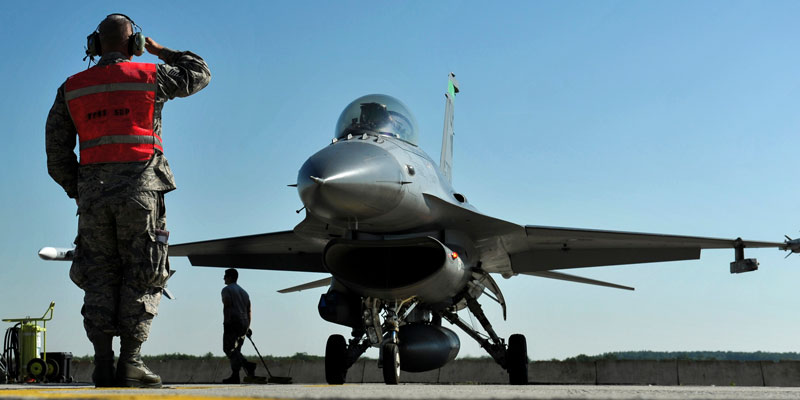
The U.S. Air Force is being stretched to the limit, with budget constraints and a growing pilot shortage, Air Force Secretary Heather Wilson and Chief of Staff Gen. David Goldfein told a news briefing on Thursday.
“The fiscal year ’18 continuing resolution is actually delaying our efforts to increase the readiness of the force,” Wilson said. “And risk accumulates over time, and you just don’t know exactly when things will break. But we are stretching the force to the limit, and we need to start turning the corner on readiness.”
Wilson said restoring readiness means lifting sequestration and hiring more people:
Last summer, we were reporting to people that we were about 1,500…pilots short in the Air Force, and we expected it to get worse.
As the fiscal year closed, we assessed where we were with respect to pilots. And I’m announcing today that, at the close of the last fiscal year, we were 1,926 pilots short. So almost…2,000 pilots short of a force that has 20,000 pilots. So that’s one in 10 that we’re short.
It’s not just pilots, though, and air crew, when it comes to readiness. It is spare parts and flying hours and munitions. So increasing the readiness of the force so that we win any fight, any time, is our top priority.
Wilson said burnout is one reason for the pilot shortage: “We are too small for all the missions that we’re being asked to carry out on behalf of the nation,” she said. “And as a result, we’re burning out our people.”
“Surge has become the new normal in the United States Air Force, and you can do that for a year, or two years, or maybe even three or four years. But we’re asking — I met someone last week who was on — who has just come back from his 17th deployment — 17 deployments,” Wilson said.
“Less than one percent of Americans serve in uniform and protect the rest of us, and they are carrying a very heavy burden. And at some point, families make a decision: that they just can’t keep doing this at this pace, and I think that’s — that’s the biggest thing we’re facing, is we’re burning out our people, because we’re too small for what the nation is asking.”
To make up for some of the pilot shortfall, President Trump on Oct. 20 signed an executive order allowing the Air Force to recall (on a voluntary basis) as many as 1,000 retired pilots to active-duty staff positions.
“You may have heard that we got authority to welcome back retirees,” Goldfein told reporters. “I will tell you that my 85-year-old dad, who flew F-4s in Vietnam, and his fellow retiree — they are all excited about coming back.”
Goldfein added that boosting the number of pilots will be a “longer-term investment.”
And Wilson noted that “you can’t train a pilot in just a year.”
“You have to absorb them into a squadron and get them — you know, get them qualified on a weapon system.
“I was talking to a parent last week, out in Colorado, whose son is a — is a director of operations up in Alaska for the F-22. And he’s flying, you know? He’s — and his dad said, ‘Gosh, you’re a pretty senior guy to be flying. Why are you flying with your squadron?’
“He said, ‘Dad, we only have three instructor pilots in the whole squadron. We’ve got all these youngsters, and they have to be trained to be able to do the mission.’ So we’re just really short of people who can teach in the squadron.”
The manpower shortage also extends to Air Force ground and maintenance crews, the people who work on airplanes and their weapons systems before takeoff.
Goldfein gave the following example:
You know, when I started flying airplanes as a young F-16 pilot, I would meet my crew chief and a — dedicated and a secondary crew chief at the plane. We’d walk the airplane — walk around the airplane. I’d taxi out. I’d meet a crew that was in the runway, and they’d pull the pins and arm the weapons and give me a last-chance check. I’d take off. I’d fly to a destination. A different crew would meet me.
Here’s what often happens today. You taxi slow because the same single crew chief that you met has to get in the van and drive to the end of the runway to pull the pins and arm the weapons.
And then you sit on the runway before you take off and you wait, because that crew chief has to go jump on a C-17 with his tools to fly ahead to meet you at the other end.
This the level of — of numbers that we’re dealing with here. We’re making the mission happen but we’re having to do it, very often, on the backs of our airmen.
And so we’re going to have — the — the tension on the force right now is significant. And so we’re looking for all these different ways to not only retain those that we have invested in but increase production so we can provide some reduction on the tension on the force right now.
Wilson said the Air Force has created an Air Crew Crisis Task Force to come up with solutions to the pilot shortfall and training deficiencies. She said the most important thing is to get rid of the Budget Control Act (sequester).
(By Susan Jones, courtesy CNSNews.com)
Don’t miss out! Subscribe today to have Alabama’s leading headlines delivered to your inbox.